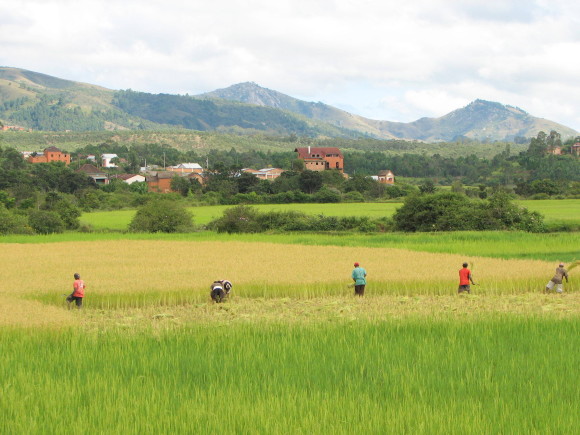Last updated on February 22, 2013
(Note: This is a guest post from my friend, colleague, and coauthor Christine Moser, who is an associate professor of economics at Western Michigan University, and whose research agenda lies at the intersection of development economics and environmental economics.)

The system of rice intensification (SRI) was developed in the 1980s by a French priest working with farmers in Madagascar and has since been promoted in rice-producing countries around the world. SRI occasionally makes an appearance in the international press, such as in this recent article in The Guardian.
Proponents of SRI tout not just the yield gains derived from the technique, but the fact that SRI does not require purchased inputs such as chemical fertilizer or improved seeds, and therefore should be accessible to the poor. SRI can also greatly reduce water use, a huge advantage in some parts of the world.
In other words, SRI is a pro-poor, environmentally friendly technology that dramatically increases yield.
But is SRI the next green revolution? In my work studying farmers in five villages in Madagascar where SRI had been promoted (see here and here), I found that 15 percent of rice farmers were using SRI, but even among these adopters, very few farmers applied the method to all of their available rice land. Perhaps more importantly, 40 percent of farmers who had tried the method had abandoned it by the time of the study.
In 2012, a student from Wageningen University traveled to Madagascar to revisit those farmers. While the high attrition rate in the sample makes it impossible to calculate exact numbers, the use of SRI practices appears to have remained the same or increased only slightly.
At first glance, this is puzzling: If, on the one hand, SRI is a sham or is not sustainable, then all farmers should abandon it over time. If, on the other hand, SRI is superior, most farmers should eventually adopt and apply the method to all of their land.
I have seen the amazing yield increases possible with this method, but yield isn’t everything. The main obstacles to adoption among the farmers in my study were the amount and timing of labor the method requires. Farmers without sufficient family labor and without money to hire laborers will have trouble adopting. Other farmers might not have adequate drainage and irrigation.
In that regard, SRI is not that different from other technologies such as improved or genetically modified seeds, or chemical fertilizers and pesticides. There is a long history of farmers failing to adopt technologies deemed by others to be better than what they currently have. But farmers are neither stubborn nor stupid, and they usually have very good reasons for not adopting what appear to be more productive practices.
Technologies that bring life-changing improvements in one part of the world may not do so in another due to different agro-ecological or market conditions, and farmers often face obstacles to adoption such as risk, liquidity constraints and labor. Identifying and helping farmers overcome those obstacles and offering farmers an array of different options will do more for improving farmer productivity than pushing one “miracle” solution.